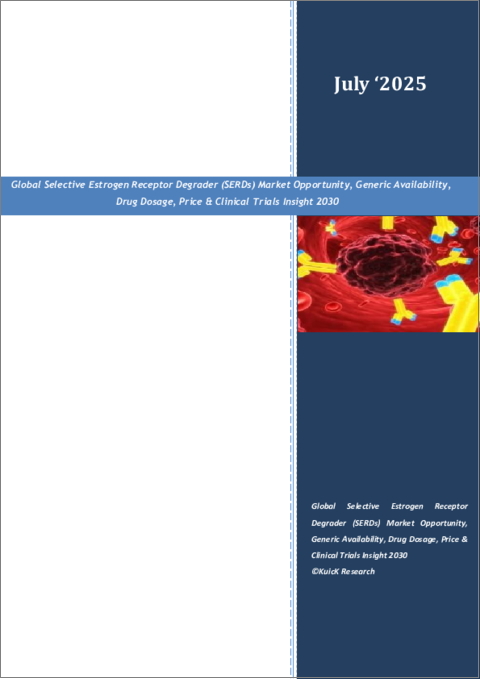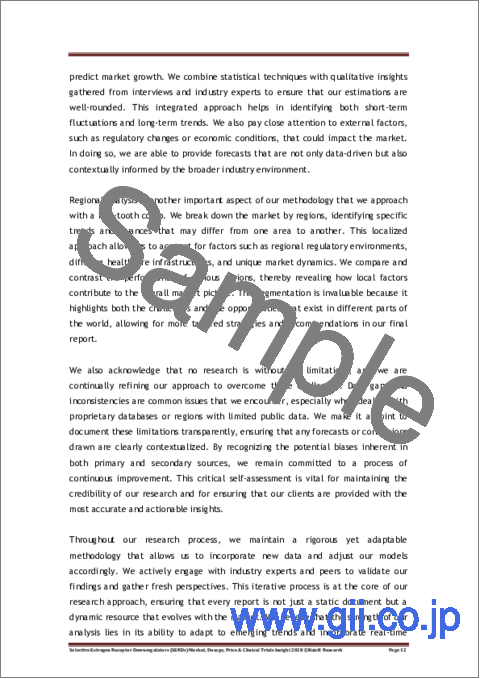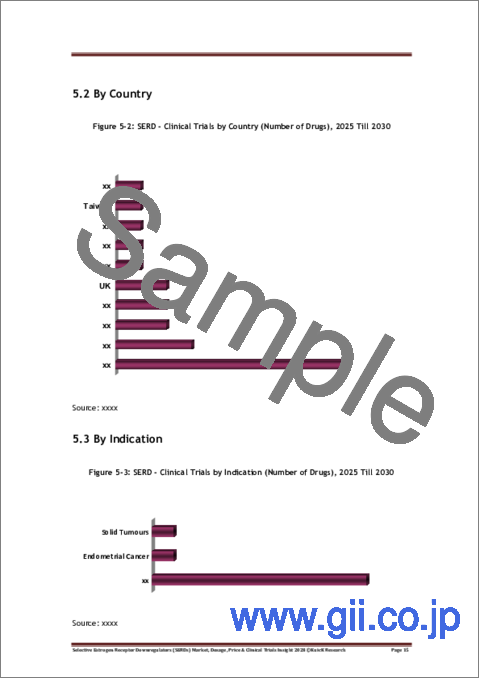|
|
市場調査レポート
商品コード
1759331
選択的エストロゲン受容体分解薬(SERD)の世界市場 - 市場の機会、ジェネリック医薬品の入手可能性、薬剤用量、価格、臨床試験の動向(2030年)Global Selective Estrogen Receptor Degrader (SERDs) Market Opportunity, Generic Availability, Drug Dosage, Price & Clinical Trials Insight 2030 |
||||||
|
|||||||
| 選択的エストロゲン受容体分解薬(SERD)の世界市場 - 市場の機会、ジェネリック医薬品の入手可能性、薬剤用量、価格、臨床試験の動向(2030年) |
|
出版日: 2025年07月01日
発行: KuicK Research
ページ情報: 英文 110 Pages
納期: 即日から翌営業日
|
全表示
- 概要
- 図表
- 目次
選択的エストロゲン受容体分解薬(SERD)の世界市場 - 市場の機会、ジェネリック医薬品の入手可能性、薬剤用量、価格、臨床試験の動向(2030年)レポートの調査結果とハイライト
- 調査手法
- 選択的エストロゲン受容体分解薬の世界市場分析と動向洞察
- 承認薬の用量、特許概要、承認スケジュール、価格と償還シナリオ
- 承認薬剤数:2薬剤
- フルベストラントのジェネリック医薬品の入手可能性と価格分析:25を超えるジェネリック医薬品
- 選択的エストロゲン受容体分解薬(SERD)の企業別、国別、適応症別、相別臨床試験インサイト
- 選択的エストロゲン受容体分解薬の適応症別応用
2000年代初頭以降、選択的エストロゲン受容体分解薬(SERD)を取り巻く環境は、フルベストラントの導入を皮切りに大きく変化しました。エストロゲンのシグナル伝達を阻害するだけのそれまでの内分泌療法とは対照的に、SERDはエストロゲン受容体を積極的に分解するという新たな優位性を持っていました。これは受容体の活性を止めるだけでなく、ホルモン受容体陽性でHER2陰性の乳がん細胞のその後の増殖を制限しました。患者がアロマターゼ阻害剤や選択的エストロゲン受容体モジュレーターに対する耐性を獲得するにつれて、SERDはより効果的で持続性のある治療薬としてすぐに普及しました。
AstraZenecaからファスロデックスという商品名で販売されているフルベストラントは、米国FDAなどの規制当局から承認された最初のSERDです。当初はタモキシフェン抵抗性の患者に対する単剤療法として使用されていましたが、すぐに人気を博し、CDK4/6阻害剤のような他の薬剤と併用されるようになっています。フルベストラントは、臨床的エビデンスの増加と世界の普及により、HR+閉経後乳がんにおける主力療法に成長しました。しかし、フルベストラントの特許切れは大きな変化をもたらしました。2019年にジェネリック医薬品が発売されたことで、手頃な価格の製品が続々と登場し、市場力学が大きく変化しました。世界中で25種類以上のジェネリック医薬品が発売され、ファスロデックスの市場シェアは低下する一方、フルベストラントのジェネリック医薬品の使用量は急増し、現在では総使用量の半分以上を占めています。
この変遷は、2023年にFDAが承認したオーセルデュ(エラセストラント)の技術革新のギャップをもたらしました。オーセルデュの特徴は、経口剤であること、すなわちSERDクラスで初めてであることとなっています。フルベストラントの筋肉内注射に代わる簡便な治療薬であり、標準的な内分泌治療に抵抗性を示すESR1遺伝子変異患者の一部のみに承認されました。オーセルデュの承認は、明らかな臨床的空白を埋めただけでなく、医薬品開発者や臨床医のSERDへの関心を再活性化させました。
オーセルデュのような経口SERDにスポットライトが当たったことで、パイプラインブームが巻き起こり、いくつかの次世代化合物が中期から後期の臨床試験に入ることになっています。Eli Lilly、Roche、AstraZeneca、Olema Oncologyは、バイオアベイラビリティの低さやESR1遺伝子変異を有する患者における活性の低さといったフルベストラントの限界を克服すべく、それぞれ独自の候補を推し進めています。これらの候補の中で最も有望なのは、イムルネストラント、ジレデストラント、カミゼストラント、パラゼストラント、タラガレストラントで、いずれも現在後期段階にあります。これらのうちいくつかは、単剤療法としてだけでなく、進行した疾患における複数の耐性経路を克服する試みとして、標的療法との併用試験も行われています。
おそらく最も技術的に斬新なのは、ArvinasとPfizerが共同開発したPROteolysis Targeting Chimera(PROTAC)薬剤であるvepdegestrantです。ベプデゲストラントは、古典的な受容体拮抗作用ではなく、細胞本来のタンパク質分解機構を利用してエストロゲン受容体を分解します。第3相VERITAC-2試験が成功裏に終了し、2025年6月、PfizerとArvinasはFDAの承認を求めて新薬承認申請を行っています。ベプデゲスラントは、PROTACベースのSERDとして初めて上市される予定であり、標的分解療法の新たなフロンティアを示すものです。
SERDプラットフォームは、単剤での使用にとどまらず、CDK4/6阻害剤、PI3K阻害剤、新規分子標的薬など、他のクラスの薬剤との併用も検討しています。これらの戦略は、奏効期間を持続させ、耐性経路が治療を上回るのを防ぐようにデザインされています。
SERDの開発は現在のところ乳がんが中心ですが、卵巣がんや子宮内膜がんなど、エストロゲン受容体を介する他の悪性腫瘍でも注目されるようになってきています。さらに、前臨床研究では、神経精神疾患、代謝性疾患、慢性疼痛など、非腫瘍への応用が検討されています。これらは初期段階ではありますが、新たなフロンティアとなる可能性を秘めています。
SERD市場は、承認された医薬品の数こそ少ないもの、急速に発展し、ダイナミックで競争力のある市場となっています。深いパイプライン、洗練された臨床試験プログラム、PROTACsのような新技術により、SERDはすでにホルモン受容体駆動型がんの治療展望に革命を起こそうとしています。
当レポートでは、世界の選択的エストロゲン受容体分解薬(SERD)市場について調査し、市場の概要とともに、適応症別、地域別の動向、および市場に参入する企業のプロファイルなどを提供しています。
目次
第1章 調査手法
第2章 選択的エストロゲン受容体分解薬(SERD)のイントロダクション
第3章 選択的エストロゲン受容体分解薬の適応症別応用
- 乳がん
- その他のがん
- その他
第4章 選択的エストロゲン受容体分解酵素阻害薬市場分析
- 市販されている選択的エストロゲン受容体分解薬
- 現在の市場シナリオ
- 将来の商業化の機会
第5章 選択的エストロゲン受容体分解酵素阻害薬の臨床試験の概要
- 企業別
- 国別
- 適応症別
- 患者セグメント別
- 相別
第6章 選択的エストロゲン受容体分解薬(SERD)の臨床試験の洞察
- 第I相
- 第I/II相
- 第II相
- 第III相
第7章 市販の選択的エストロゲン受容体分解薬(SERD)に関する考察
第8章 ファスロデックス- 初めて市販された選択的エストロゲン受容体分解薬
- 承認と特許の概要
- 価格と投与量分析
- 売上分析
- Faslodex-償還シナリオ
第9章 ジェネリックフルベストラント- 入手可能性と価格分析
第10章 オルセルデュ-2番目に市販されている選択的エストロゲン受容体分解薬
- 承認と特許の概要
- 価格と投与量分析
- Orserdu-償還シナリオ
第11章 競合情勢
- AstraZeneca
- Eli Lilly
- EnhancedBio
- Olema Oncology
- Radius Therapeutics
- Roche
List of Figures
- Figure 2-1: Evolution of Selective Estrogen Receptor Degraders
- Figure 2-2: Role of Estrogen Receptor in Tumor Development
- Figure 2-3: Mechanism of Selective Estrogen Receptor Degraders
- Figure 2-4: Mechanism of SERDs in Combination with other Cancer Therapeutics
- Figure 2-5: CDK 4/6 Inhibitors Used in Combination with Selective Estrogen Receptor Degraders
- Figure 2-6: PI3K Inhibitors Used in Combination with Selective Estrogen Receptor Degraders
- Figure 2-7: Aromatase Inhibitors Used in Combination with Selective Estrogen Receptor Degraders
- Figure 2-8: mTOR Inhibitors Used in Combination with Selective Estrogen Receptor Degraders
- Figure 3-1: Breast Cancer - Estimated Incidence & Mortality (Millions), 2045
- Figure 3-2: Selective Estrogen Receptor Degraders in Development
- Figure 3-3: VERITAC-2 Phase 3 (NCT05654623) Trial - Study Initiation & Completion Year
- Figure 3-4: VERITAC-3 Phase 3 (NCT05909397) Trial - Study Initiation & Completion Year
- Figure 3-5: EvoPAR-BR01 Phase 3 (NCT06380751) Trial - Study Initiation & Completion Year
- Figure 3-6: CAMBRIA-1 Phase 3 (NCT05909397) Trial - Study Initiation & Completion Year
- Figure 3-7: CAMBRIA-2 Phase 3 (NCT05952557) Trial - Study Initiation & Completion Year
- Figure 3-8: SERENA-4 Phase 3 (NCT04711252) Trial - Study Initiation & Completion Year
- Figure 3-9: SERENA-6 Phase 3 (NCT04964934) Trial - Study Initiation & Completion Year
- Figure 3-10: OPERA-01/OP-1250-301 Phase 3 (NCT06016738) Trial - Study Initiation & Completion Years
- Figure 3-11: OP-1250-001 Phase 1/2 (NCT04505826) Trial - Study Initiation & Completion Years
- Figure 3-12: OP-1250-003 Phase 1 (NCT04964934) Trial - Study Initiation & Completion Year
- Figure 3-13: EMBER-3 Phase 3 (NCT04975308) Trial - Study Initiation & Completion Year
- Figure 3-14: EMBER-4 Phase 3 (NCT05514054) Trial - Study Initiation & Expected Completion Year
- Figure 3-15: persevERA Phase 3 (NCT04546009) Trial - Study Initiation & Expected Completion Year
- Figure 3-16: lidERA Phase 3 (NCT04961996) Trial - Study Initiation & Expected Completion Year
- Figure 3-17: heredERA Phase 3 (NCT05296798) Trial - Study Initiation & Expected Completion Year
- Figure 3-18: evERA Phase 3 (NCT05306340) Trial - Study Initiation & Expected Completion Year
- Figure 3-19: pionERA Phase 3 (NCT06065748) Trial - Study Initiation & Expected Completion Year
- Figure 3-20: 2017-0405 Phase 2 (NCT03531645) Trial - Study Initiation & Expected Completion Year
- Figure 3-21: 18-107 Phase 2 (NCT03643510) Trial - Study Initiation & Expected Completion Year
- Figure 3-22: CASE2820 Phase 2 (NCT05113368) Trial - Study Initiation & Expected Completion Year
- Figure 4-1: Fulvestrant & Elacestrant - Mechanism of Action
- Figure 4-2: Selective Estrogen Receptor Degraders Market - Future Opportunities
- Figure 5-1: SERD - Clinical Trials by Company (Number of Drugs), 2025 Till 2030
- Figure 5-2: SERD - Clinical Trials by Country (Number of Drugs), 2025 Till 2030
- Figure 5-3: SERD - Clinical Trials by Indication (Number of Drugs), 2025 Till 2030
- Figure 5-4: SERD - Clinical Trials by Patient Segment (Number of Drugs), 2025 Till 2030
- Figure 5-5: SERD - Clinical Trials by Phase (Number of Drugs), 2025 Till 2030
- Figure 8-1: Faslodex - FDA Approval Years by Breast Cancer Type
- Figure 8-2: Faslodex - FDA Approval Year & First Generic Approval Year
- Figure 8-3: Faslodex - Price per Unit & Supply of Intramuscular Injection (US$), July'2025
- Figure 8-4: Faslodex - Recommended & Reduced Dose (mg)
- Figure 8-5: Faslodex - Number of Doses by Treatment Phase
- Figure 8-6: Faslodex - Cost For First & Subsequent Treatment Cycles (US$)
- Figure 8-7: Global - Faslodex Annual Sales (US$ Million), 2019-2023
- Figure 8-8: US - Faslodex Annual Sales (US$ Million), 2019-2023
- Figure 8-9: EU - Faslodex Annual Sales (US$ Million), 2019-2023
- Figure 8-10: ROW - Faslodex Annual Sales (US$ Million), 2019-2023
- Figure 8-11: Global - Faslodex Quarterly Sales (US$ Million), 2023
- Figure 8-12: Global - Faslodex Annual Sales by Region (US$ Million), 2023
- Figure 8-13: Global - Faslodex Annual Sales by Region (%), 2023
- Figure 8-14: US - Faslodex Quarterly Sales (US$ Million), 2023
- Figure 8-15: EU - Faslodex Quarterly Sales (US$ Million), 2023
- Figure 8-16: ROW - Faslodex Quarterly Sales (US$ Million), 2023
- Figure 9-1: Fulviglen - Price per Unit & Supply of 3 Intramuscular Injections (US$), July'2025
- Figure 9-2: Fulviglen - Price per Unit & Supply of 6 Intramuscular Injections (US$), July'2025
- Figure 9-3: Fulviglen - Price per Unit & Supply of 9 Intramuscular Injections (US$), July'2025
- Figure 9-4: Fulvenat - Price per Unit & Supply of 120 mg Intramuscular Injection (US$), July'2025
- Figure 9-5: Fulvenat - Price per Unit & Supply of 250 mg Intramuscular Injection (US$), July'2025
- Figure 9-6: Fulvetraz - Price per Unit & Supply of 50 mg Intramuscular Injection (US$), July'2025
- Figure 9-7: Fulvetraz - Price per Unit & Supply of 250 mg Intramuscular Injection (US$), July'2025
- Figure 9-8: Fuvestrol - Price per Unit & Supply of 250 mg Intramuscular Injection (US$), July'2025
- Figure 9-9: Strantas - Price per Unit & Supply of 250 mg Intramuscular Injection (US$), July'2025
- Figure 9-10: Celvestrant - Price per Unit & Supply of 250 mg Intramuscular Injection (US$), July'2025
- Figure 9-11: Faslomax - Price per Unit & Supply of 250 mg Intramuscular Injection (US$), July'2025
- Figure 9-12: Fasnorm - Price per Unit & Supply of 250 mg Intramuscular Injection (US$), July'2025
- Figure 9-13: India - Price per Unit & Supply of Fulveryze Intramuscular Injections (INR/US$), July'2025
- Figure 9-14: India - Price per Unit & Supply of Vestrant Intramuscular Injections (INR/US$), July'2025
- Figure 9-15: India - Price per Unit & Supply of Fulvether Intramuscular Injections (INR/US$), July'2025
- Figure 9-16: India - Price per Unit & Supply of Fulveser Intramuscular Injections (INR/US$), July'2025
- Figure 9-17: India - Price per Unit & Supply of Fulzos Intramuscular Injection (INR/US$), July'2025
- Figure 9-18: India - Price per Unit & Supply of Fistent Intramuscular Injection (INR/US$), July'2025
- Figure 9-19: India - Price per Unit & Supply of Fulpost Intramuscular Injection (INR/US$), July'2025
- Figure 9-20: India - Price per Unit & Supply of Fulvested Intramuscular Injection (INR/US$), July'2025
- Figure 9-21: India - Price per Unit & Supply of Fulvaa Intramuscular Injection (INR/US$), July'2025
- Figure 9-22: India - Price per Unit & Supply of Fulbreca Intramuscular Injection (INR/US$), July'2025
- Figure 9-23: India - Price per Unit & Supply of Fulvekast Intramuscular Injection (INR/US$), July'2025
- Figure 9-24: Europe - Price for Supply of Teva Fulvestrant Intramuscular Injection (GBP/US$), July'2025
- Figure 9-25: Europe - Price for Supply of Zentiva Fulvestrant Intramuscular Injection (GBP/US$), July'2025
- Figure 9-26: Europe - Price for Supply of Sandoz Fulvestrant Intramuscular Injection (GBP/US$), July'2025
- Figure 9-27: Europe - Price for Supply of AAH Fulvestrant Intramuscular Injection (GBP/US$), July'2025
- Figure 9-28: Europe - Price for Supply of Thornton & Ross Fulvestrant Intramuscular Injection (GBP/US$), July'2025
- Figure 9-29: Europe - Price for Supply of Dr. Reddy's Fulvestrant Intramuscular Injection (GBP/US$), July'2025
- Figure 9-30: Europe - Price for Supply of Kent Fulvestrant Intramuscular Injection (GBP/US$), July'2025
- Figure 9-31: Europe - Price for Supply of Amneal Pharmaceuticals Fulvestrant Intramuscular Injection (GBP/US$), July'2025
- Figure 10-1: Orserdu - US Patent Grant & Expiration years
- Figure 10-2: Orserdu - Price per Unit & Supply of Oral Tablets (US$), July'2025
- Figure 10-3: EU - Price per Unit & Supply of (US$), July'2025
List of Tables
- Table 3-1: Breast Cancer - Selective Estrogen Receptor Degraders In Clinical Trials
- Table 4-1: Globally Approved Branded SERDs
- Table 10-1: Orserdu - Dose Reduction Levels for Adverse Reactions
- Table 10-2: Orserdu - Dosage Modification Guidelines for Adverse Reaction
Global Selective Estrogen Receptor Degrader (SERDs) Market Opportunity, Generic Availability, Drug Dosage, Price & Clinical Trials Insight 2030 Report Findings & Highlights:
- Research Methodology
- Global Selective Estrogen Receptor Degrader Market Analysis & Trends Insight
- Approved Drugs Dosage, Patent Overview, Approval Timeline, Pricing & Reimbursement Scenario
- Number Of Approved Drugs: 2 Drugs
- Generic Fulvestrant Availability & Price Analysis: > 25 Generics
- Selective Estrogen Receptor Degrader (SERD) Clinical Trials Insight By Company, Country, Indication & Phase
- Selective Estrogen Receptor Degraders Application By Indication
Since the early 2000s, the landscape for Selective Estrogen Receptor Degraders (SERDs) has significantly changed, starting with the introduction of fulvestrant as the first in class drug. In contrast to previous endocrine therapies that only inhibited estrogen signaling, SERDs had a new edge by actively degrading the estrogen receptor. This not only stopped receptor activity but also limited the subsequent proliferation of hormone receptor-positive, HER2-negative breast cancer cells. As patients developed resistance to aromatase inhibitors and selective estrogen receptor modulators, SERDs soon became popular as a more effective and long-lasting therapeutic agent.
Fulvestrant, marketed under the brand name Faslodex by AstraZeneca, was the first SERD to be approved by regulatory authorities like US FDA. Initially used as a monotherapy for tamoxifen resistant patients, it soon gained popularity and was used in combination with other agents like CDK4/6 inhibitors. It grew over the years to become a mainstay therapy in HR+ postmenopausal breast cancer, owing to increasing clinical evidence and global uptake. The patent expiration of fulvestrant, however, brought about a significant change. The launch of generics in 2019 triggered a tide of affordable versions, significantly changing its market dynamics. With over 25 generics on the market worldwide, Faslodex market share has declined while generic fulvestrant use has skyrocketed, now representing over half of total usage.
This transition left an innovation gap that was addressed in 2023 with FDA approval of Orserdu (elacestrant), which was originally developed by Radius Health and then acquired by Menarini Group. What set Orserdu apart was its oral form, i.e., the first in the SERD class. It provided a convenient alternative to fulvestrant's intramuscular injection and was approved solely for a subpopulation of ESR1-mutation patients, who commonly become resistant to standard endocrine treatments. Orserdu's approval not only filled an evident clinical void but also reinvigorated interest in SERDs among pharmaceutical developers and clinicians.
The spotlight on oral SERDs such as Orserdu has set off a pipeline boom, as several next generation compounds find their way into mid to late stage clinical trials. Eli Lilly, Roche, AstraZeneca, and Olema Oncology are all pushing their own candidates, each trying to build on fulvestrant's limitations, such as poor bioavailability and short activity in patients with ESR1 mutations. Among the most promising of these candidates are imlunestrant, giredestrant, camizestrant, palazestrant, and taragarestrant, which all currently reside in late-phase testing. Several of these are not only being tested as monotherapies but also in combination with targeted therapies in an attempt to overcome multiple resistance pathways in advanced disease.
Perhaps the most technologically novel entries to this scene is vepdegestrant, a PROteolysis Targeting Chimera (PROTAC) drug co-developed by Arvinas and Pfizer. Instead of acting via classical receptor antagonism, vepdegestrant enlists the cell's native protein degradation machinery to degrade the estrogen receptor. With the completion of the successful Phase 3 VERITAC-2 trial, in June 2025 Pfizer and Arvinas filed an NDA seeking FDA approval. Vepdegestrant is set to be the first PROTAC-based SERD to hit the market, signaling a new frontier in targeted degradation therapy.
Beyond monotherapy use, the SERD platform is investigating combinations with other classes of agents including CDK4/6 inhibitors, PI3K inhibitors, and novel molecularly targeted agents. These strategies are designed to sustain the duration of response and prevent resistance pathways from outpacing treatment.
Although SERD development is presently centered on breast cancer, they are now gaining attention in other malignancies of the estrogen receptor-mediated nature, such as ovarian and endometrial cancers. Further, preclinical studies are investigating their use in non-oncologic applications like neuropsychiatric disorders, metabolic disorders, and chronic pain. Although these are in the initial stages, they are potential new frontiers.
The SERD market, while narrow in terms of approved medicines, has developed with rapid evolving into a dynamic and competitive landscape. With deep pipelines, sophisticated trial programs, and new technologies such as PROTACs, SERDs are already set to revolutionize the treatment landscape for hormone receptor-driven cancers and quite possibly much more.
Table of Contents
1. RESEARCH METHODOLOGY
2. Introduction to Selective Estrogen Receptor Degraders (SERDs)
- 2.1 Overview & Evolution of SERDs
- 2.2 Selective Estrogen Receptor Degraders - Mechanism of Action
- 2.3 Selective Estrogen Receptor Degraders in Combination Therapies
3. Application Of Selective Estrogen Receptor Degraders By Indication
- 3.1 Breast Cancer
- 3.2 Other Cancers
- 3.3 Other Applications
4. Selective Estrogen Receptor Degrader Market Analysis
- 4.1 Commercially Approved Selective Estrogen Receptor Degraders
- 4.2 Current Market Scenario
- 4.3 Future Commercialization Opportunity
5. Selective Estrogen Receptor Degrader Clinical Trials Overview
- 5.1 By Company
- 5.2 By Country
- 5.3 By Indication
- 5.4 By Patient Segment
- 5.5 By Phase
6. Selective Estrogen Receptor Degrader (SERD) Clinical Trials Insight
- 6.1 Phase I
- 6.2 Phase-I/II
- 6.3 Phase-II
- 6.4 Phase-III
7. Marketed Selective Estrogen Receptor Degrader (SERD) Insight
8. Faslodex - 1st Commercially Available Selective Estrogen Receptor Degrader
- 8.1 Approval & Patent Overview
- 8.2 Pricing & Dosage Analysis
- 8.3 Sales Analysis
- 8.4 Faslodex - Reimbursement Scenario
9. Generic Fulvestrant - Availability & Price Analysis
10. Orserdu - 2nd Commercially Available Selective Estrogen Receptor Degrader
- 10.1 Approval & Patent Overview
- 10.2 Pricing & Dosage Analysis
- 10.3 Orserdu - Reimbursement Scenario
11. Competitive Landscape
- 11.1 AstraZeneca
- 11.2 Eli Lilly
- 11.3 EnhancedBio
- 11.4 Olema Oncology
- 11.5 Radius Therapeutics
- 11.6 Roche





